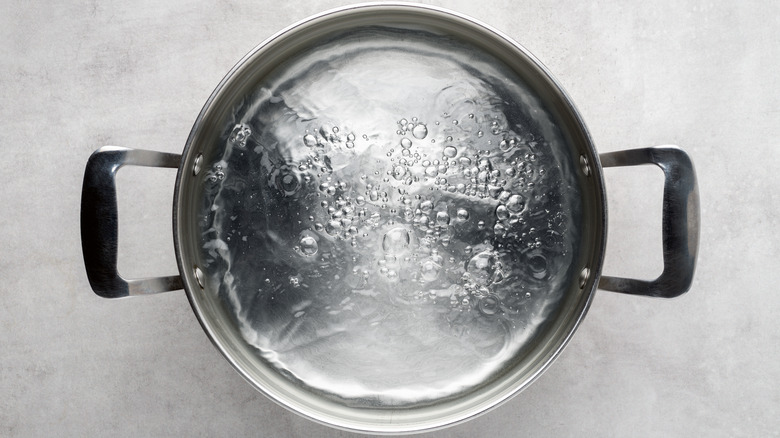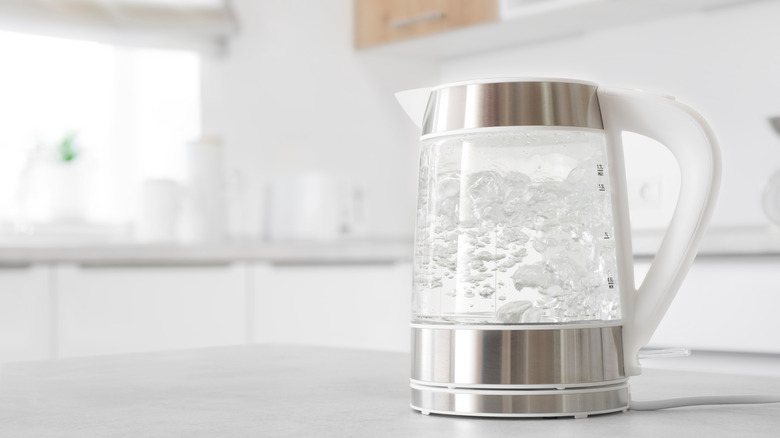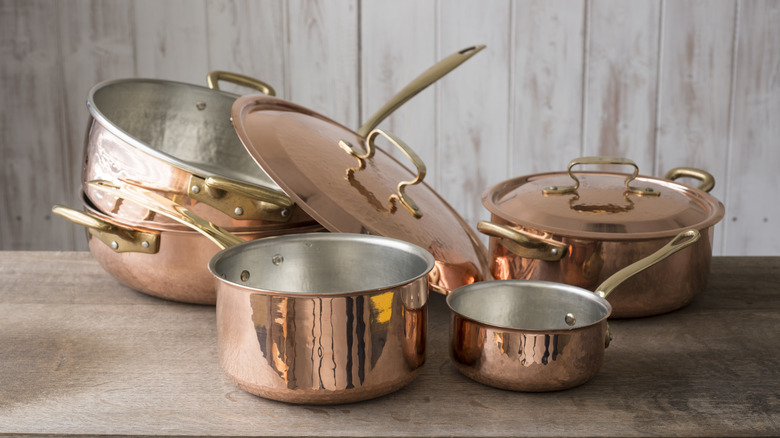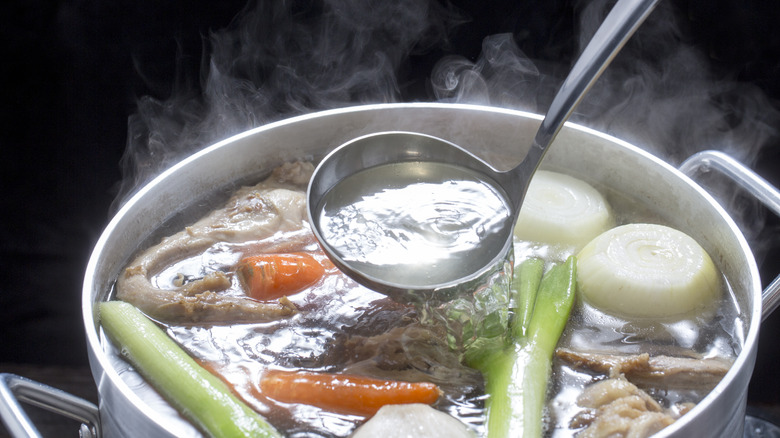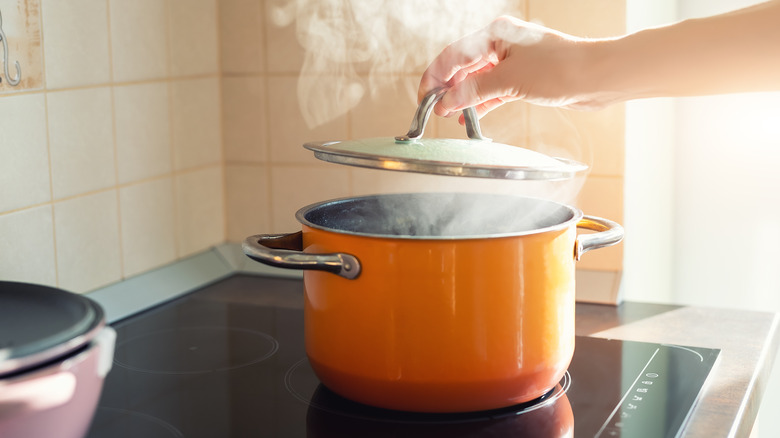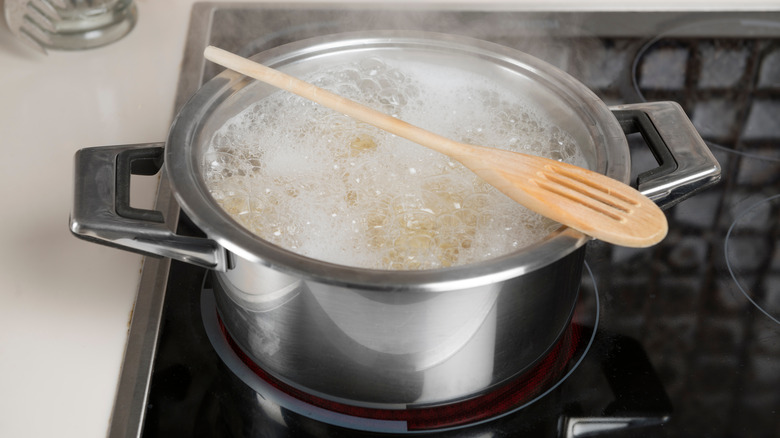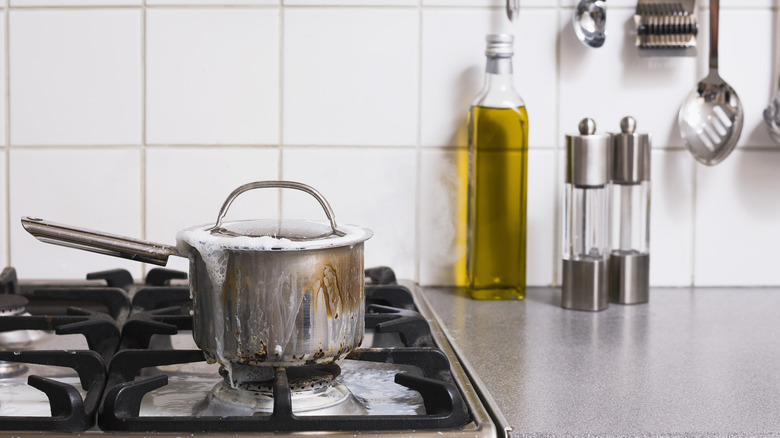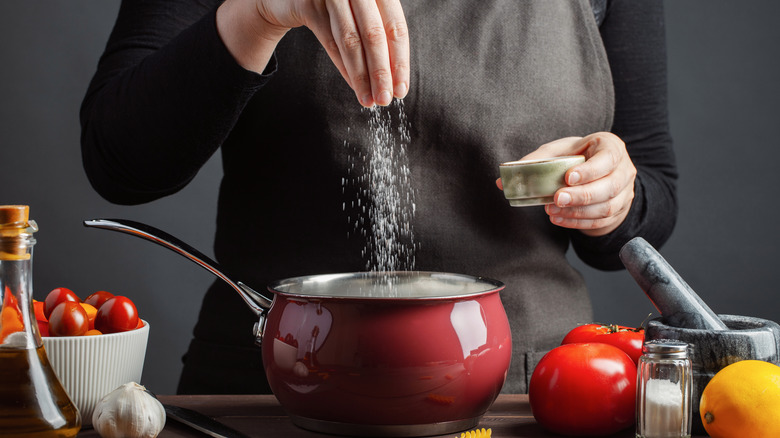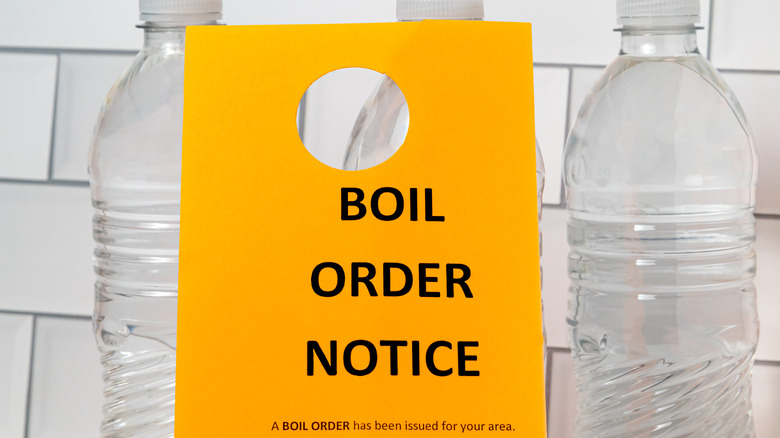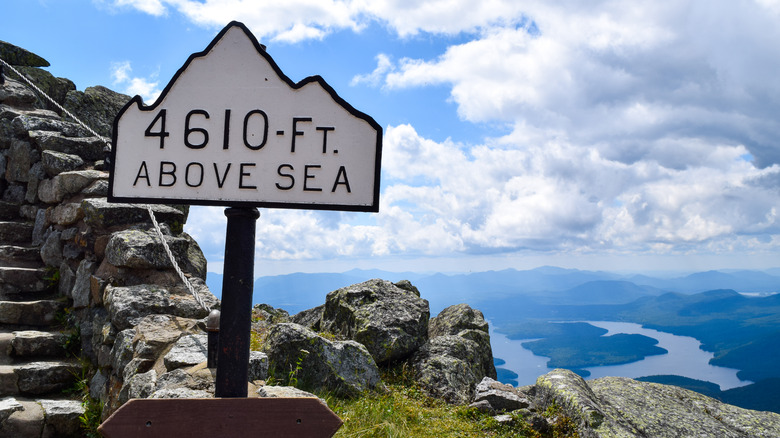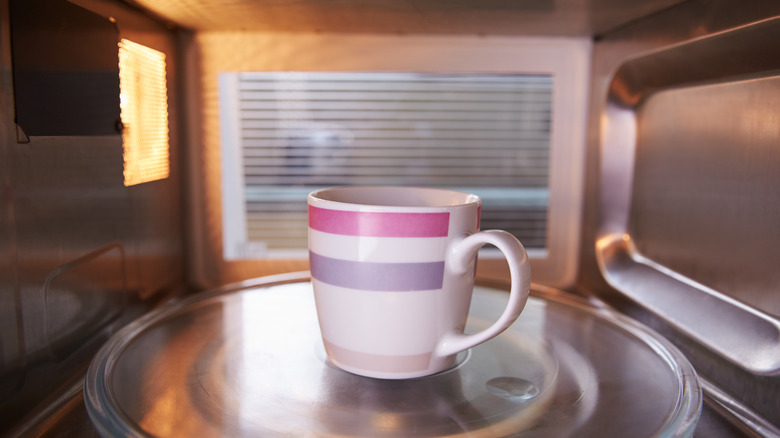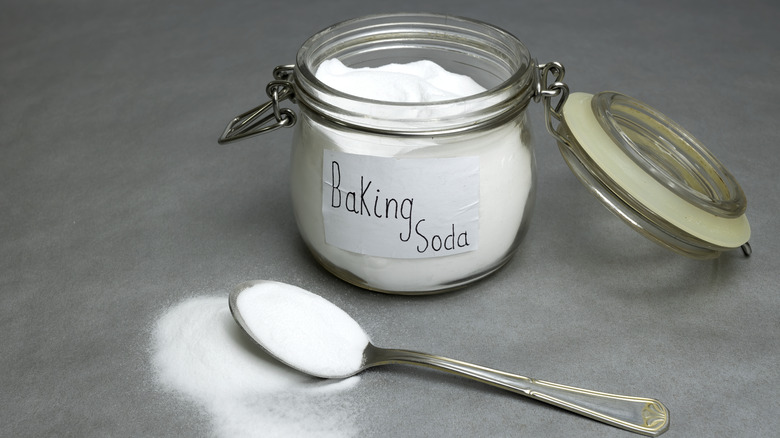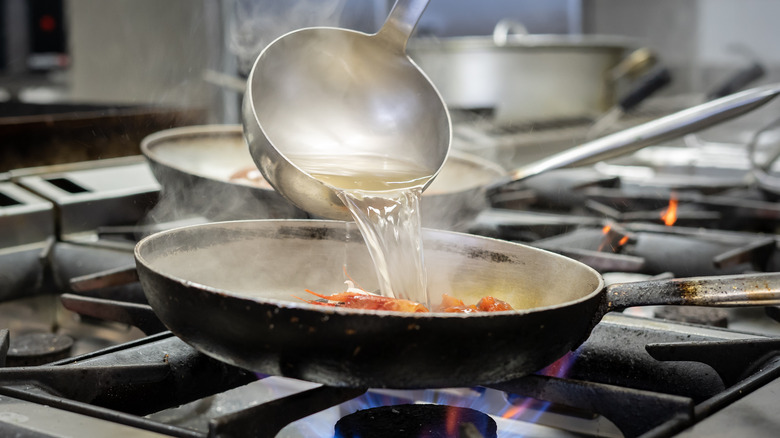12 Unexpected Tips You Need When Boiling Water
Bringing a pot of water to a boil is often one of the first steps in many recipes from hearty pasta or rice dishes to a bowl of creamy mashed potatoes. This essential kitchen skill is necessary for blanching vegetables, hard-boiling eggs, and creating quick, easy meals for busy weeknights or even camping trips. Whether out on the trail or under a boil water advisory following a storm, knowing how to boil water safely and efficiently can be a life-saving skill.
Boiling water is the result of a complex process in which heating the water to a certain point, 212 degrees Fahrenheit or 100 degrees Celsius at sea level, will cause bubbles of water vapor to rise and collapse, causing turbulent movement that further helps heat the water in the pot (via NASA). The rolling boil that lets us know it's time to add our pasta or vegetables is actually the product of multifaceted chemistry that can be impacted by everything from the type of stovetop you use and the size of the pot to impurities in the water and the altitude at which you are cooking. This simple yet critical step may appear as easy as filling a pot with water and turning on the stovetop. But before you turn on that burner, there are some unexpected tips that you need when boiling water to make your cooking faster, safer, and more efficient.
1. Boil efficiently
Boiling water quickly and efficiently begins before you even pour water into your pot. The type of heat source you are using plays a significant role in how quickly your pot begins to bubble or your tea kettle begins to whistle. In response to a curious tea enthusiast, PBS News explored the most energy-efficient way to boil water by examining four different appliances. In an at-home experiment, an induction stove heated two cups of water the fastest, followed by an electric tea kettle. The test did not include gas stoves.
Despite the gas versus electric stove debate about which is safer, they are roughly the same when it comes to efficiency. Although using natural gas directly circumvents the need for power plants and electricity, much of the energy is used on the air around the flame rather than actually heating the water, dropping its efficiency down to around 70%, which is on par with an electric stove. The study found that our individual behavior has a greater impact than the appliance we use. For example, we lessen the efficiency when we boil more water than we need or leave the pot on well beyond when the water has come to a boil. Go ahead and turn the dial all the way up too since boiling on medium will only take longer, wasting both time and energy.
2. Choose the right pot for the job
When it comes to boiling water, size does matter. It's easy to simply grab the first pot available and fill it with water, but taking a few moments to find the right size pot for the job can make boiling water faster as well as improve the cooking process. The size of the pot and the amount of water can affect how long you'll have to wait for the water to boil as well as the quality of the final dish. Using a wide pot or pan increases the surface area, exposing more of the water to the heat, which works well for long or thin vegetables, for example, but might not be the ideal choice for larger foods like potatoes or a head of cauliflower.
For starchy foods like potatoes or pasta, you will want a larger pot with tall sides to minimize the risk of boiling over. Pasta will also cook more evenly and be less prone to clumping when cooked in a larger pot. However, to quickly blanch vegetables, you might opt for a smaller pot or wide pan which will boil faster with less water and more concentrated heat. In addition to choosing the right pot for the job, be sure to use only as much water as you need to save yourself some time as well as energy.
3. Bring water to a boil before reducing to simmer
If you have ever watched Food Network's "Worst Cooks in America," you might recall Chef Anne Burrell's penchant for the catchy mantras and acronyms she chants to the contestants. Does anyone else think of "slices, sticks, dices" every time they chop vegetables? Frequently repeated throughout the show is "BTB, RTS," which stands for "bring to boil, reduce to simmer." It may seem counterintuitive to crank the heat up to a rolling boil just to turn it back down, but this technique actually speeds up the process and offers a greater level of control throughout cooking.
MasterClass explains that simmering is gentler than a rolling boil with less movement that allows flavors to meld while better maintaining the structural integrity of the ingredients. This makes simmering an ideal method for recipes that require braising, slow cooking, or reducing liquids. In contrast, boiling is a high-heat method that is better suited for processes such as poaching and blanching. To employ the BTB, RTS technique, bring your liquid to a boil in order to establish the heat, then bring the temperature back down, giving the ingredients time to integrate with one another as you slow the cooking process.
4. Use a lid to boil water faster
When dinner time rolls around and your stomach is growling, the last thing you want to do is stare at a pot of water, tortuously waiting for it to boil. Thankfully, you don't need any fancy tools or special equipment to make your water boil at least a little bit faster. Simply close the pot with its lid or anything you can use to create a snug seal over the pot. Adding a lid traps more of the water vapor and heat inside the pot, allowing the water to reach a full boil more quickly.
A California Science Fair project by Ronja Johnson tested this simple trick to save time and reduce energy usage in your everyday cooking routine. Comparing a pot closed with a lid to an open one, the experiment showed that using a lid reduced the average boiling time by about 25%, or just over one minute. Use this helpful tip in addition to turning the heat to high, using the right pot, and pouring only the water you need to get your water boiling in practically no time.
5. Prevent boil over with the spoon trick
A wooden spoon is a versatile kitchen tool that can handle a lot of tasks in the kitchen. This environmentally-friendly, all-purpose utensil is safe to use with cast iron and non-stick cookware and won't melt or leach unpleasant tastes into hot food. This affordable kitchen staple can also save a pot of potatoes from boiling over, leaving a foamy, water mess on your stovetop. Simply place a wooden spoon across the top of a pot of boiling water to prevent the bubbles from spilling over. When the bubbles reach the cool, dry wood of the spoon, they burst and release steam, which prevents the water from boiling over.
While celebrity chef Michael Symon suggests using a larger pot to prevent boil over, Food Network icon Geoffrey Zakarian is a proponent of the wooden spoon trick when preparing pasta, grains, or starchy vegetables. The Naked Scientists explain that boil over is often the result of two reactions. First, when pasta or other foods are added to boiling water, it increases the surface area for bubbles to form on, producing a surge that can spill out of the pot. Second, boiling foods such as grains or potatoes loosens up the starch or gluten they contain which also contributes to the foam rising out of the pot. To lessen this reaction, turn to the wooden spoon trick and save yourself from a messy stovetop.
6. Use cooking spray to stop boil over
Even if you don't own a wooden spoon, you can lessen the risk of boil over while cooking pasta, rice, or potatoes with another ubiquitous kitchen ingredient: cooking spray. Coat the inside of the pot with a spritz of nonstick spray before filling the pot with water in order to hinder the bubbles from rising up and over the edge of the pot. If the bubbles threaten to overflow during the cooking process, simply spray the surface to help quell the foam.
Why does this work? The American Chemical Society tells us that oil is less dense than water and therefore will float creating a thin layer that calms the starchy water bubbles by repelling them as they try to penetrate the surface tension imposed by the oil. There are tools specifically made to minimize boil over, such as a silicone stopper, but a simple wooden spoon or spritz of cooking spray works just as well, saving you money and valuable space in your kitchen drawer.
7. Understand the science of salt
There's plenty to know about salt because it's arguably the most important ingredient in the culinary world. The beloved mineral is a crucial seasoning, provides essential nutrients, and plays a vital role in food preservation. When it comes to boiling water, there is somewhat of a debate about whether salt slows down or speeds up the process. You may have encountered an old wives' tale that claims adding salt to water before it boils can cause the water to take much longer to bubble. However, this is only partially true.
While the addition of salt can heat water more quickly, it also raises the water's boiling point, negating the expedited temperature increase and causing the salted water to boil only slightly faster by perhaps a few seconds (via Live Science). Why then does a sprinkle of salt create a flurry of bubbles when added to simmering water? When a handful of salt is dropped into the water, each tiny crystal provides a nucleation point, more disruptive surface area from which bubbles can form, as the Naked Scientists explain. Although adding salt appears to neither promote nor hinder the boiling process, salting the water can still impact the flavor of the final dish. Pasta, for example, absorbs salt from the cooking water, giving it a deeper flavor than only seasoning the pasta after it has cooked.
8. Learn how to boil safe drinking water
Whether backpacking on a remote trail or under a boil water order at home after a powerful storm, knowing how to boil safe drinking water is a critical survival skill. If a local health agency issues a boil water advisory, it means they believe the water in the community may be contaminated with germs that could cause illness. In this circumstance, a health agency such as the Centers for Disease Control and Prevention may recommend using bottled or boiled water for drinking and preparing food for people and pets as well as brushing your teeth or cleaning toys and surfaces. Do not use water from appliances connected to the water line, such as ice or water from a refrigerator.
In order to render contaminated water safe for drinking, it should be boiled to certain specifications. The water needs to reach a rolling boil, maintaining this vigorous pace for at least one full minute. How long the water must boil depends on altitude, since the boiling point lowers as altitude increases. At altitudes over 5,000 feet, water must be boiled for no less than three minutes to be considered safe to drink. Once the water has boiled for the appropriate length of time, it should be allowed to cool naturally and stored in clean, covered containers.
9. Adjust for altitude
When cooking or baking at a higher altitude, some adjustments must be made to accommodate for the changes in atmospheric pressure and humidity. According to the United States Department of Agriculture, the thinner, dryer air experienced at higher altitudes can have numerous effects on basic cooking processes. Most cookbooks consider making adjustments for high altitudes if you are preparing food above 3,000 feet.
As atmospheric pressure decreases with altitude, the boiling point of water also decreases by approximately 1 degree Fahrenheit with each 500-foot increase in elevation. In order to compensate for the lower boiling point, the cooking time must increase. This change can affect anything from making a batch of hard-boiled eggs to the efficiency of an Instant Pot. The differences in pressure and humidity can also cause water to evaporate faster leaving foods to dry out or burn if they are not covered while cooking. Colorado State University offers helpful advice for high-altitude food preparation with an online guide covering a variety of methods and dishes from canning and slow cooking to baking cookies, cakes, and breads.
10. Do not try to boil water in the microwave
Although the microwave can be a time-saving tool for reheating leftovers or warming a mug of tea, there are some foods that should not be microwaved. While microwaving is not recommended for some products due to unappealing textures or tastes, others are advised against as a safety precaution. Most of us know not to put aluminum foil or styrofoam in the microwave, but trying to boil water in a microwave can also be quite dangerous. Overheating water in the microwave, known as superheating, could actually cause the water to explode.
Following reports of serious skin burns and scalding injuries, the Food and Drug Administration released recommendations on how to avoid this dangerous phenomenon. When water is microwaved in a clean cup, it can heat past its boiling point without the appearance of boiling. The risk of superheating is much higher with distilled water than with tap due to the number of impurities generally present in tap water. When the cup is agitated or foreign materials are added, such as sugar or instant coffee granules, the disturbance may result in a violent eruption of overheated water from the cup. "Mythbusters" demonstrated this exploding water scenario in a dramatic fashion. To avoid the dangers of superheated water, do not heat liquids in the microwave over a long amount of time and stick to the manufacturer's instructions for your microwave.
11. Don't fall for water boiling myths
Though a seemingly mundane kitchen task, techniques for boiling water are often steeped in myth and hearsay. Many of these common old wives' tales have been dismissed by science, yet they still persist as home cooks and outdated recipe books perpetuate them to the next generation. One persistent myth is that cold water boils faster than water that is hot or at room temperature. Scientific American took this claim to task, proving it false with some basic chemistry. The rate of heating depends on the amount of difference in temperature between the liquid and its surroundings. Although cold water will absorb heat faster, the heating rate slows as the water warms and takes just as long to reach a boil as water at any other temperature.
Another myth surrounding boiling water that pops up on occasion is that adding baking soda will make the water boil faster. As JLab explains, baking soda does raise the temperature slightly when added to water. However, the effect on the time it takes for the water to boil is negligible, leaving this myth also debunked. Even though it won't get your water boiling any faster, baking soda does have some other helpful uses in the kitchen such as speeding up the Maillard reaction for faster browning, balancing acidity in soups, tenderizing meat, and getting sinks and cookware squeaky clean.
12. Make the most of water that's already boiling
Once you have your water at a boil, you can make the most of the time and energy you spent by using it for multiple purposes. For example, quickly blanch some vegetables before adding your pasta for a quick one-pot meal. Once you remove the pasta or vegetables you were boiling, you might go ahead and throw some eggs in the water to hard boil for breakfast or a protein-rich snack. While preparing a pot of instant noodles, Netflix host and Great British Bake Off winner Nadiya Hussain realized she could save time and hassle by tossing whole bulbs of garlic into boiling water for easier peeling.
Don't toss your leftover pasta water either! Water that was used to boil pasta, potatoes, eggs, or other vegetables can be repurposed in a number of ways. Reserved pasta water contains starches that can thicken sauces or add a salty element to soups and stews. Similarly, substituting starchy, leftover potato water for some of the milk will thicken your mashed potatoes or even firm up gravy in place of a cornstarch slurry. Once it has cooled, the water used to boil pasta, eggs, or vegetables can become a nourishing, natural fertilizer for your garden.
